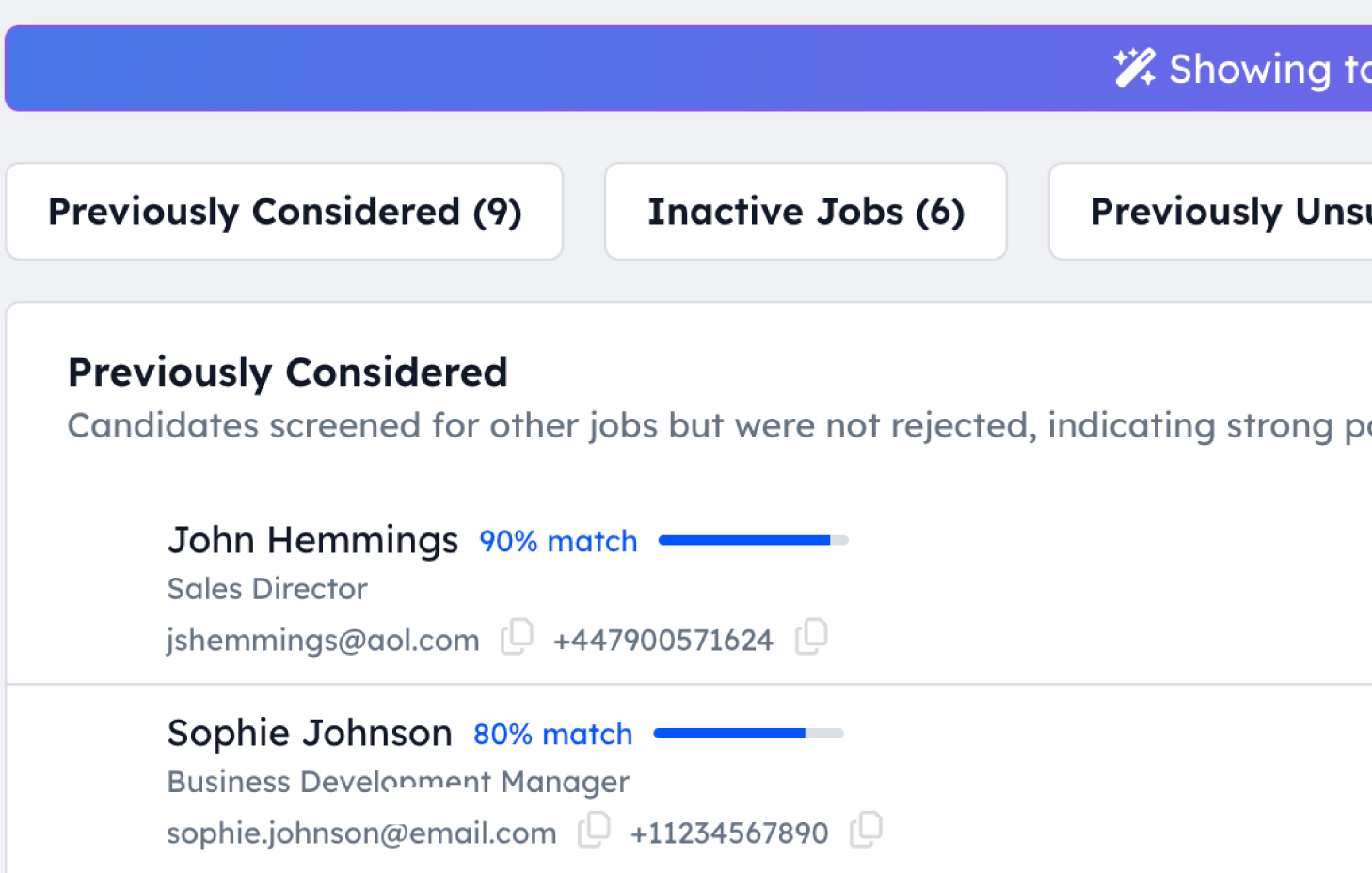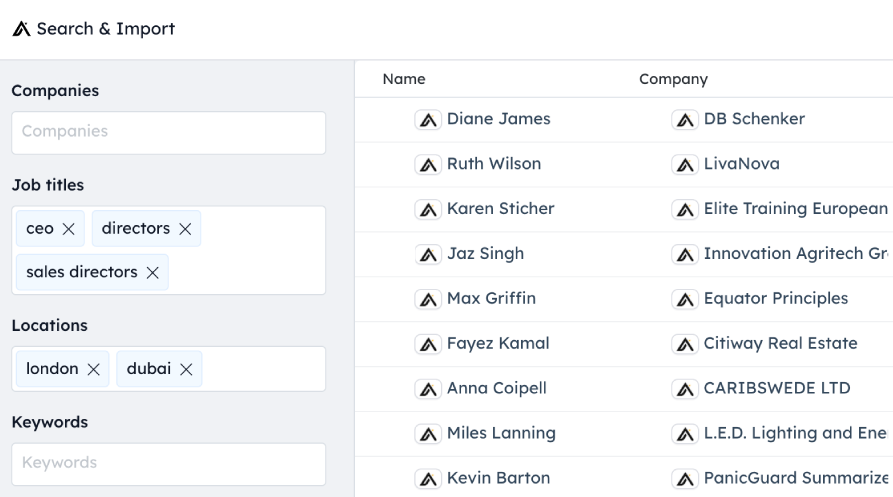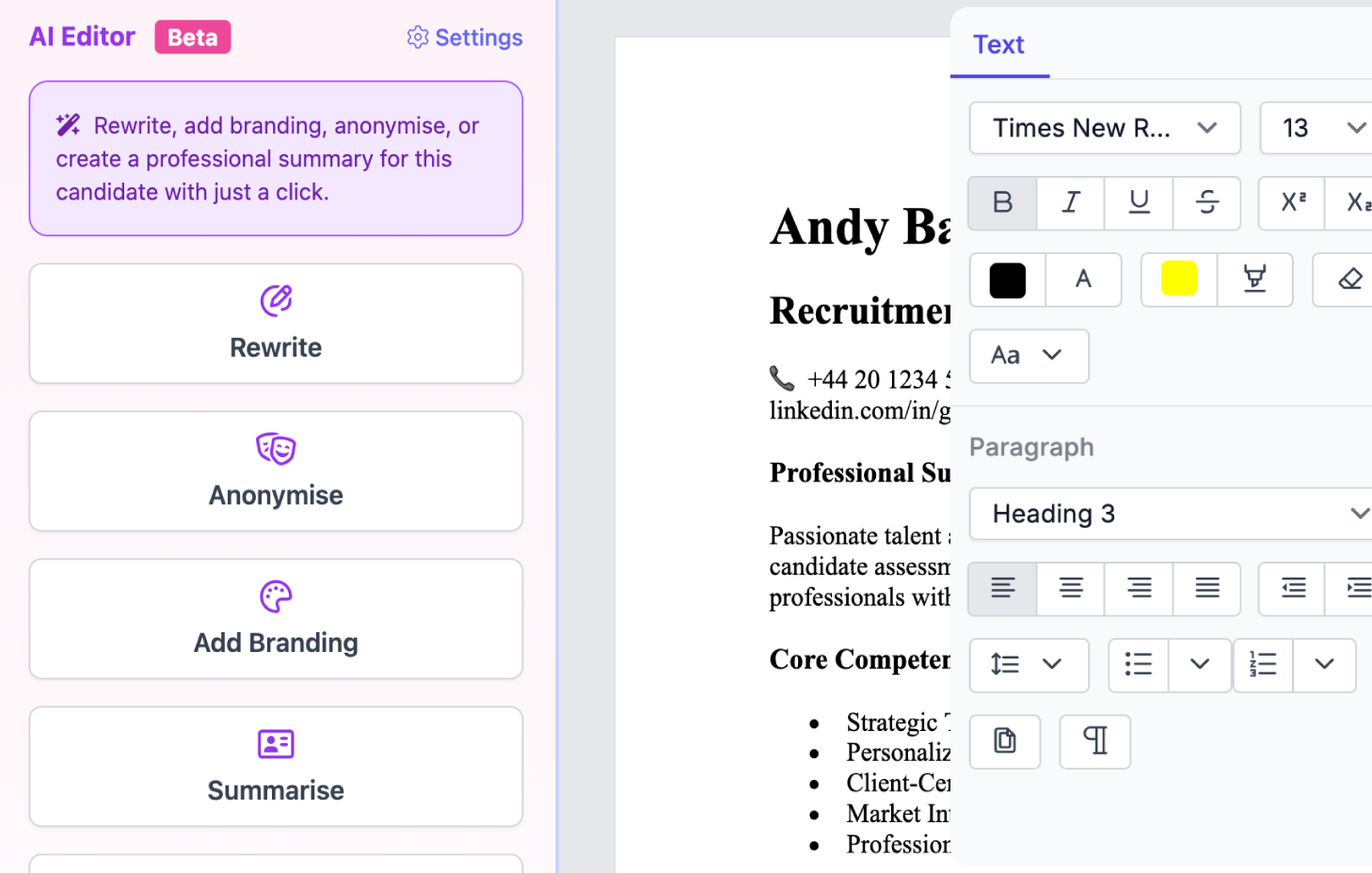The #1 Recruiting CRM
Built for Agencies
Source. Place. Invoice. Grow.
All in one place!
Source candidates, manage pipelines, and grow your agency - all in one powerful platform.The only platform that actually works the way recruiters do. Everything you need to run a successful recruiting agency - in one place.

Submit Shortlists in Minutes, Not Days
Search your entire database instantly. Match candidates to jobs with AI. Send branded shortlists before your client's coffee gets cold.
Source
800M+ Profiles
Built-in database with verified contact details
Research
AI Fact-Checking
Verify skills, availability & career progression
Submit
Client-Ready
Branded shortlists delivered in seconds
Find Perfect Candidates You Forgot You Had
That contractor you placed 3 years ago? They are perfect for this role. Our AI searches beyond keywords to understand skills, experience, and career progression - surfacing candidates you would never find with traditional search.
Auto-Match to Jobs
Get instant candidate suggestions for every new job - ranked by fit
Search Like You Think
"Java developer who worked at a startup" finds exactly that
CV Insights
See career progression, skill growth, and hidden qualifications
Culture Fit Analysis
Match candidates who'll actually last in the role

Everything Else That Makes Your Life Easier
Post Once to 50+ Job Boards
One form. 5 minutes. Your job is live on Indeed, Linked1n, niche boards, and your website. Track which sources actually send quality candidates.
Know Who's Billing What
Real-time leaderboards. Individual and team targets. See who needs help before they miss their numbers. No more month-end surprises.
Your CV Goldmine, Organized
Every CV parsed and searchable in seconds. Duplicate detection. Auto-formatting with your branding. Find that perfect candidate from 2019.
Win More Clients. Keep Them Longer.
Stop cold calling hiring managers who don't return emails. Build real relationships. Track every conversation. Know exactly when to follow up.

One Click from Social Profile to Pipeline
That HR Director posting about "building our dream team"? Click. They are in your CRM with phone, email, and company intel. Your BD team can follow up before lunch.
Remember Everything
Every email, call, and meeting tracked automatically
Find the Right Person
Direct dials and emails for actual decision makers
Never Miss Follow-ups
Automated reminders based on what actually works
See What's Working
Which BD reps are actually closing deals
The Boring Stuff That Actually Wins Business
Follow-up Sequences That Work
7 touches over 30 days. Personalised. Automated. That prospect who ignored your first email? They'll reply to the fourth.
Actually Reach Decision Makers
Call from local numbers. Text confirmations. Everything logged. No more "just following up on my email" into the void.
Know Your BD Pipeline Health
How many meetings to win a client? Which companies actually give you jobs? Who on your team is crushing it? Real numbers, not guesswork.
Keep Your Database Warm & Billable
That contractor you placed 2 years ago? They are looking again. Stay top of mind with candidates and clients without lifting a finger.
They Open. They Click. They Call You.
Monthly check-ins with placed candidates. Quarterly updates to clients. Job alerts that actually match what people want. All automated, all tracked, all driving repeat business.
Looks Professional
Your branding, not ours. Every email.
Smart Sending
Best time to reach each person, automatically
Actually Lands in Inbox
Not spam folder. 95%+ delivery rate.
See Who's Interested
Bob opened 5 times? Call Bob now.

Fill Your Pipeline While You Sleep
Your Own Job Board (That Works)
Stop paying Indeed. Candidates apply on YOUR site. Applications flow straight into Recruitly. Google loves it. Candidates find it.
Know What Actually Works
Linked1n ads bringing contractors? Indeed wasting money? See which sources send candidates who actually get placed.
Application Forms That Convert
Stop losing candidates at "upload CV". Smart forms that work on mobile. Pre-fill from Linked1n. Get 3x more applications.
AI That Actually Works
Use AI to automate repetitive tasks, generate content, analyze calls, and get insights that help you work smarter.

AI-Powered Content Creation
Our AI content generation helps you create compelling job descriptions, outreach messages, emails, and marketing copy in seconds.
Job Descriptions
Create compelling, accurate JDs
Email Templates
personalised outreach messages
Marketing Copy
Blog posts, social content & more
Multi-language
Support for 20+ languages
AI-Powered Features
Call Recording & Analysis
When calls are completed through integrations like Dialpad, we automatically transcribe and extract key insights for your records.
AI Forecasting
Predictive analytics that help you anticipate hiring trends and optimise your team's focus for maximum revenue.
Smart Job Advert Composer
Create compelling, bias-free job adverts optimised for search and your target candidate audience.
Simplify Your Recruiting Tech Stack
Compare the traditional multi-tool approach with Recruitly's integrated platform
Technology Stack Cost Comparison
| Technology Area | Traditional Solution | Monthly Cost | Recruitly Cost |
|---|---|---|---|
Recruiting ATS | Separate ATS tool | $99/month | Included |
Sales CRM | Separate CRM tool | $75/month | Included |
Job Board Distribution | Broadbean/LogicMelon | $65/month | Included |
Email Marketing | Mailchimp/Constant Contact | $45/month | Included |
Outreach/Drip Campaigns | Separate Outreach Tool | $55/month | Included |
AI Tools | Various AI platforms | $40/month | Included |
Automation Tools | Zapier and custom solutions | $50/month | Included |
Monthly Total | All traditional solutions | $429/month | $149/month |
The Hidden Cost of Context Switching
Billable Hours at Risk
According to a Harvard Business Review study of 500+ recruitment agencies, your recruiters lose 5.5 hours per week switching between tools - that's 22% of billable time wasted on admin tasks.
For a team of 10 recruiters, fragmented workflows cost approximately £80,000 annually in lost revenue opportunities.
Time Lost Weekly
5.5 hours
Productivity Loss
22%
Annual Revenue Impact
£80,000
Feature-by-Feature Comparison
See how Recruitly compares to traditional solutions in each technology area
Traditional Solution
Separate ATS tool
Common Challenges
Limited candidate matching capabilities
Requires third-party integrations for modern features
Complex implementation (2-3 months)
Customer Experience
"We spent months implementing our previous ATS, only to find we needed additional tools for basic functionality. The lack of AI matching meant our recruiters spent hours manually searching for candidates."
Recruitly Solution
All-in-one platform
Key Advantages
AI-powered candidate matching using vector database
Built-in CV editor with rewrite and anonymisation
Fast implementation (2-4 weeks)
Customer Success
"We use Recruitly now for more than 3 years and are very happy. There are not too many solutions in the market that work for Recruitment Agencies. It's easy to use, they always aim to improve, and what stands out the most for us is the support and willingness to support their clients! We requested customized changes to the ATS, and they made it happen. Besides that, it's user-friendly, and our team loves the usability."
Ready to transform your recruitment tech stack?
Join hundreds of agencies saving money while improving performance.
30-minute personalised walkthrough
Note: Pricing based on industry averages for comparable solutions. Context switching costs based on Harvard Business Review study of 500+ recruitment agencies.
Average ROI with Recruitly
Save $50,000+ per year

